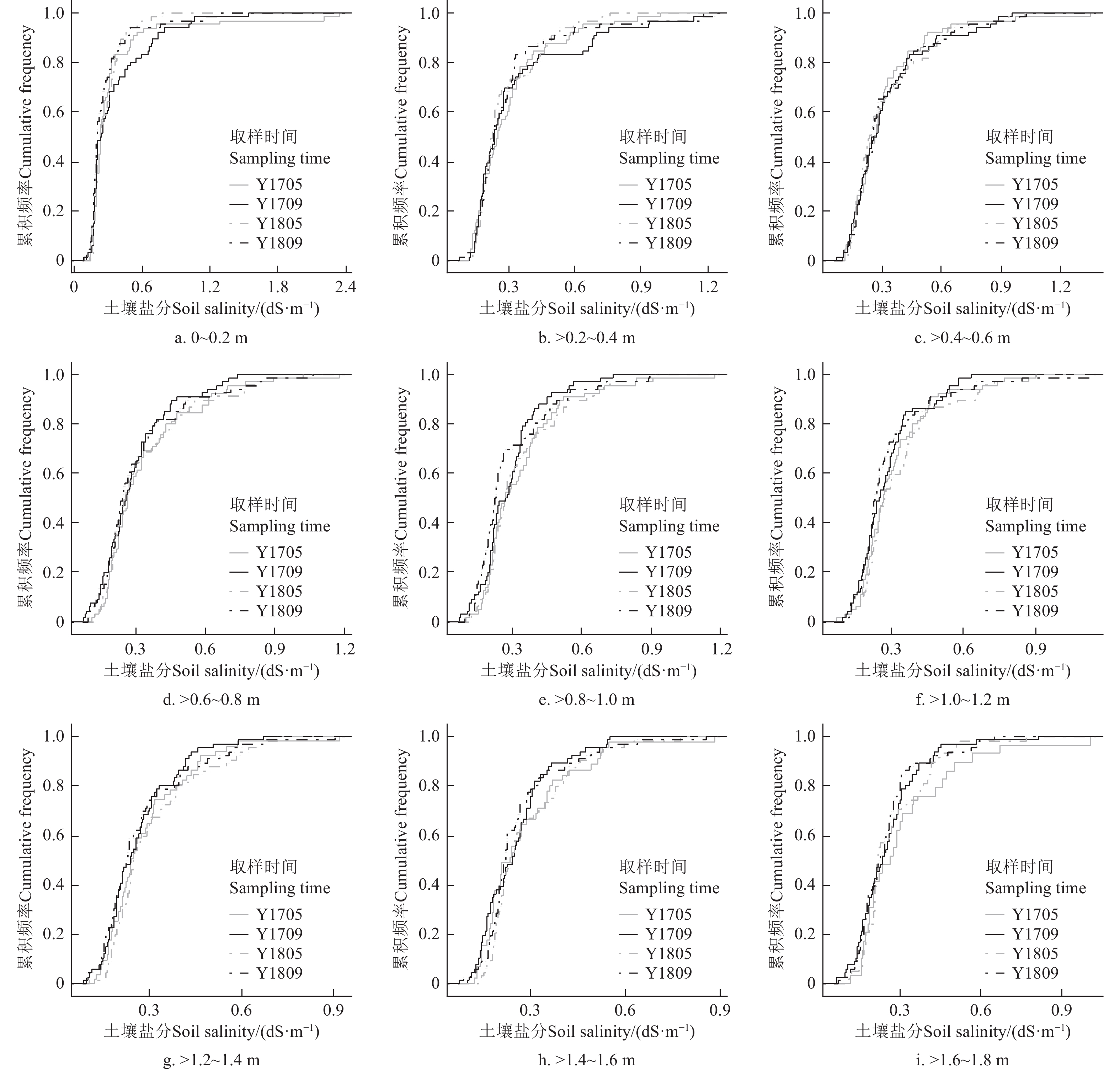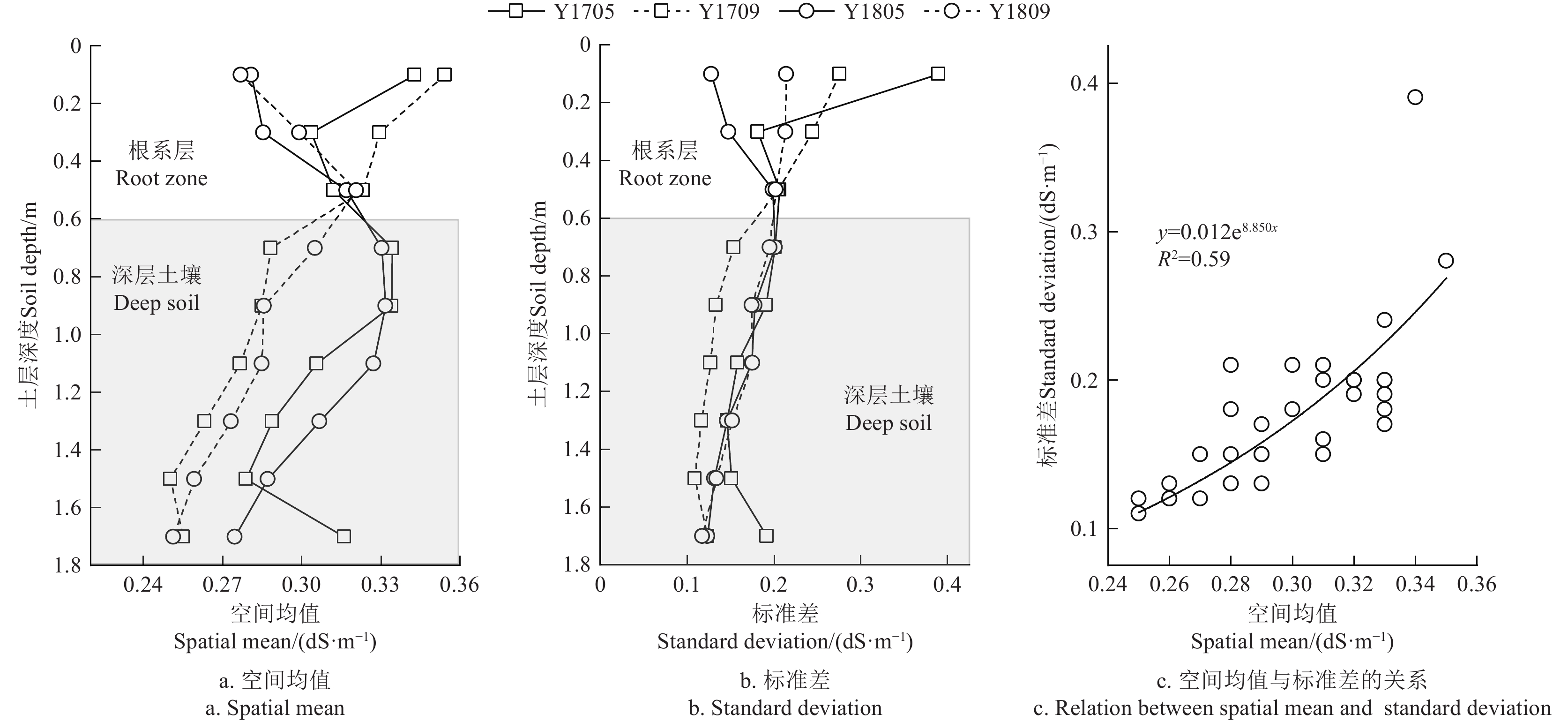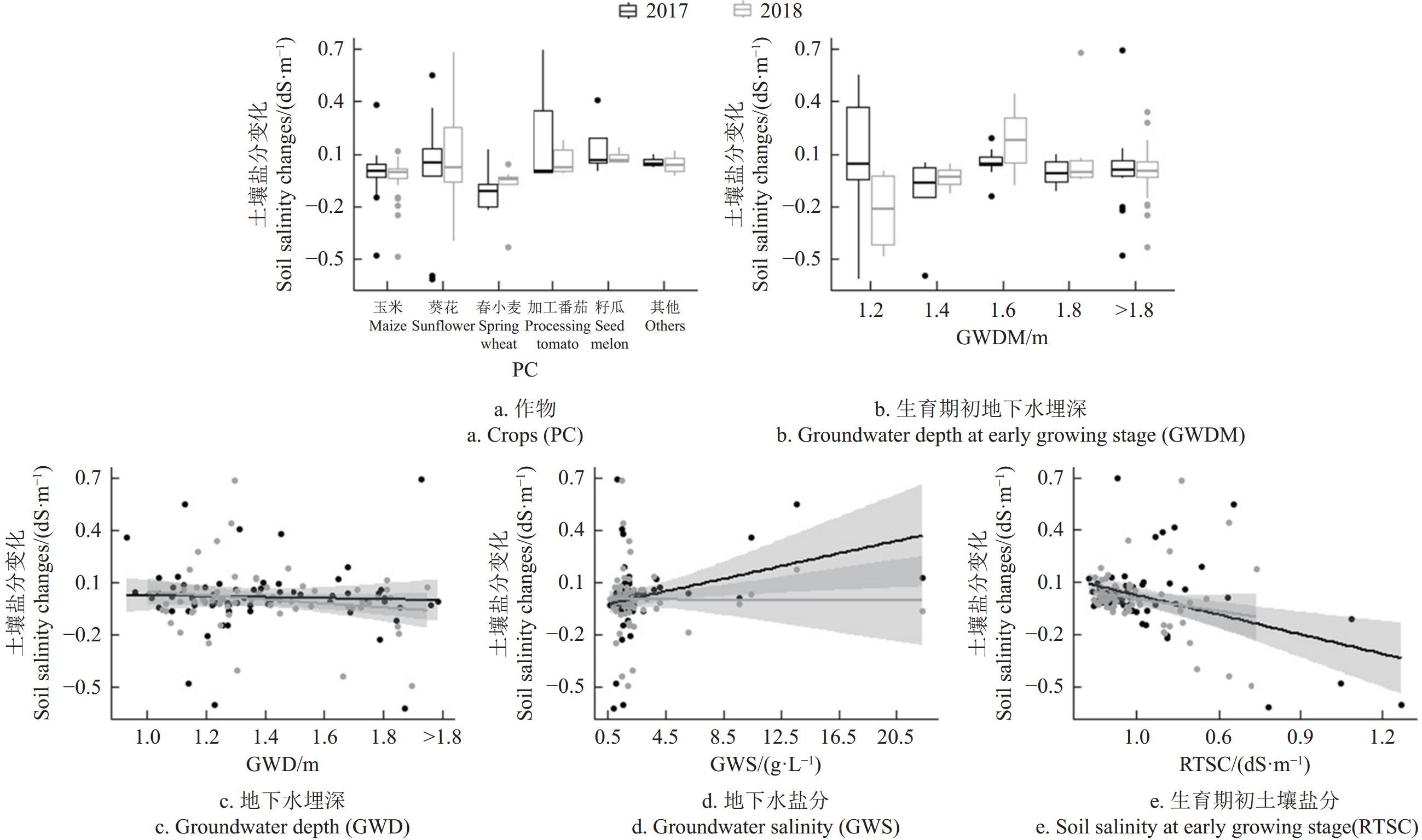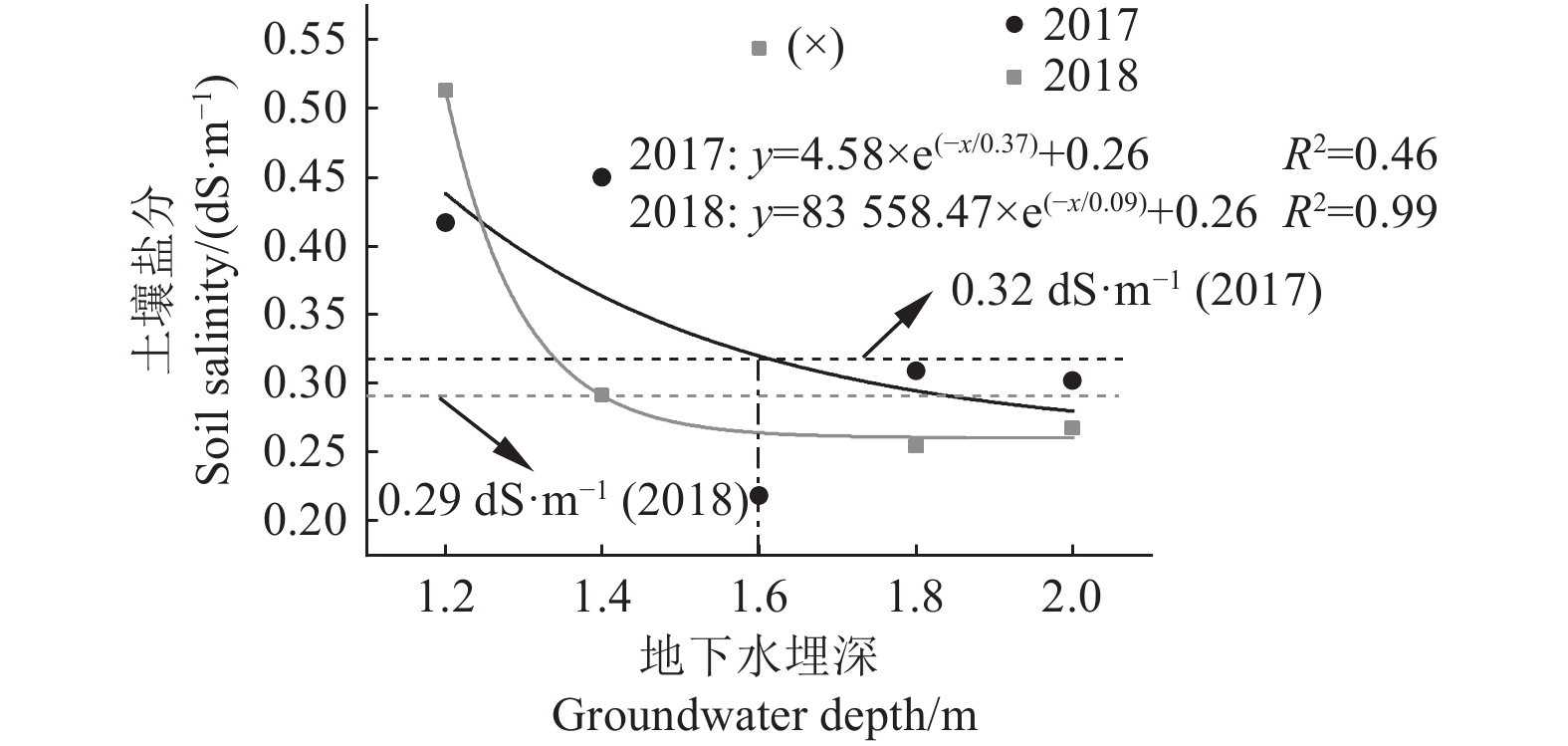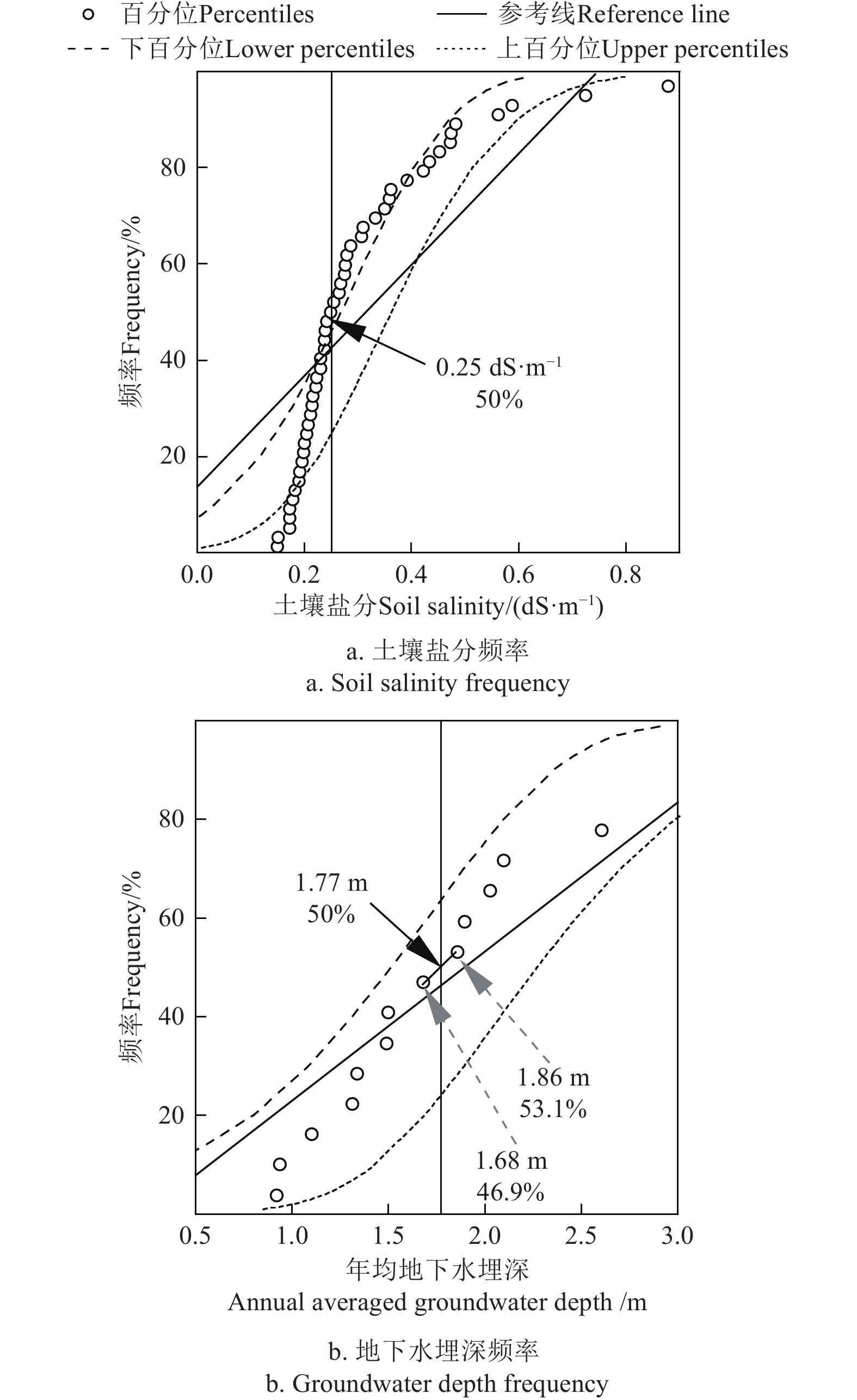Root zone and deep soil salinity dynamics and suitable groundwater depth for salt control in the Hetao Irrigation District
-
摘要:
浅地下水埋深诱发的土壤次生盐碱化是干旱灌区面临的重要生态环境问题。为探讨河套灌区根系层-深层土壤盐分动态及适宜控盐埋深,该研究基于内蒙古河套灌区隆胜研究区68块灌溉农田连续2 a生育期初和生育期末0~1.80 m的土壤盐分、地下水埋深、地下水盐分的监测和作物种植类型的调查,分析了根系层-深层土壤盐分时空动态、季节性平衡机制、多个因素(如气象条件、地下水埋深、地下水矿化度、作物类型和生育期初土壤盐分等)间相互作用对生育期土壤盐分变化的影响,探明了土壤盐分对地下水年际和季节性埋深的响应。结果表明,根系层土壤盐分均在生育期积盐,休耕期脱盐;深层土壤盐分均在生育期脱盐,休耕期积盐。作物类型、生育期初(5月初)地下水埋深、生育期地下水埋深、地下水盐分及生育期初根系层土壤盐分均对生育期根系层土壤盐分变化有显著影响(P<0.05)。地下水状况与其他各因素的相互作用对生育期根系层土壤盐分变化的影响与水文年型有密切的关系。生育期初根系层土壤盐分随着地下水埋深的增大而指数减小,土壤盐分小于均值的取样点地下水埋深不小于1.60 m。当年均地下水埋深小于2.50 m,不同土层的盐分值和盐分降低速率随地下水埋深的增加而降低。在地下水埋深小于2.50 m的条件下,以概率分布法得出根系层土壤盐分中位数对应的年均适宜临界控盐地下水埋深为1.77 m,土壤盐分远大于中位数或均值的取样点的地下水埋深均小于该埋深。因此,从控盐角度考虑,建议该研究区地下水埋深生育期初应不小于1.60 m,年均地下水埋深应不小于1.77 m。研究结果可为河套灌区通过灌溉制度的设计和排水措施的合理布局控制地下水埋深提供理论依据。
Abstract:Soil salinization is a main environmental and ecological problem in irrigated agro-ecosystems especially for the area with shallow groundwater table. Most previous studies mainly focused on the surface and root zone soil salinity, however, the knowledge on spatio-temporal dynamics of soil salinity for both root zone and deep soil as well as driving factors, and the recommended seasonal and annual groundwater depth for salt control was rarely addressed. In this study, 68 cropland sampling experiments and investigations related to soil salinity from the top soil to the depth of 1.80 m, groundwater depth and salinity, and crop types were carried out before and after the crop growing season of 2017-2018 in the Hetao Irrigation District. Soil salinity statistical characteristics showed that the standard deviation of soil salinity in time and space became larger with increasing of temporal mean and spatial mean. The root zone (within depth of 0-0.60 m) soil salinity in the crop growing season were accumulated and desalinated in the fallow season, which was opposite for changes of the deep (within depth of 0.60-1.80 m) soil salinity. The multi-factor variance analysis of variance showed that the driving factors including crop type, groundwater depth at the beginning of crop growing season, averaged groundwater depth in the crop growing season, groundwater salinity and root zone soil salinity at the beginning of crop growing season had significant effects on root zone soil salinity changes in the crop growing season (P<0.05). The influence of groundwater condition and other factors on root zone soil salinity change during crop growing season was closely related to the hydrological year type. At the beginning of crop growing season, the soil salinity in the root zone decreased exponentially with increasing groundwater depth, and the sampling locations with soil salinity below average had a minimum groundwater depth of 1.60 m. Both salt value and salt reduction rate decreased with groundwater depth increased across different soil layers when the average annual groundwater depth was less than 2.50 m. Thus, the sampling locations were selected where the groundwater table depth was less than 2.50 m, and then the median of root zone soil salinity and groundwater depth was obtained by the frequency analysis method. The annual suitable critical control groundwater depth for soil salinity median was 1.77 m. The groundwater depth of sampling locations where soil salinity was significantly higher than the median or mean value were less than 1.77 m. Therefore, in order to control soil salinity, it is recommended that the groundwater depth should be no less than 1.60 m at the beginning of crop growing period, and to maintain an average annual groundwater depth of at least 1.77 m. The research results will provide theoretical support for the design of irrigation scheduling and the rational layout of drainage projects for similar irrigation area in the arid area.
-
Keywords:
- soils /
- salts /
- crops /
- Hetao Irrigation District /
- groundwater /
- groundwater depth
-
-
图 2 4次取样时间不同深度土壤盐分累积频率分布
注:Y1705、Y1709、Y1805、Y1809分别表示2017年5月初、2017年9月末、2018年5月初、2018年9月末,下同。 Note:Y1705, Y1710, Y1805, and Y1809 represent early May 2017, the end of September 2017, early May 2018, and the end of September 2018, respectively. It’s similarly hereinafter.
Figure 2. Distribution of soil salt accumulation frequency at different depths during 4 times of sampling
图 5 生育期初根系层土壤盐分与地下水埋深的关系
注:(×)表示该数据点未纳入模型,主要是由于该点样本较少(仅有3个),盐分变异大。
Figure 5. Relationship between root zone soil salinity and groundwater depth at the beginning of crop growing period
Note: (×) indicates this data point was not included in the model because that there were only 3 samples for this point, and large soil salinity variations.
表 1 土壤盐分的空间均值和季节性变化
Table 1 Spatial mean and seasonal changes of soil salinity
(dS·m−1) 土层
Soil depth/m土壤盐分 Soil salinity 土壤盐分季节性变化 Soil salinity seasonal changes Y1705 Y1709 Y1805 Y1809 2017S1 2017S2 2018S1 0~0.6 0.32 0.34 0.29 0.30 0.01 −0.04 <0.01 >0.6~1.2 0.33 0.28 0.33 0.29 −0.04 0.05 −0.04 >1.2~1.8 0.29 0.26 0.29 0.26 −0.03 0.04 −0.03 0~1.8 0.32 0.29 0.31 0.28 −0.03 0.02 −0.02 注:2017年和2018年生育期土壤盐分的变化标记为2017S1和2018S1,休耕期Y1709到Y1805土壤盐分的变化标记为2017S2。某一季节内土壤盐分的变化是季节末土壤盐分值与季节初盐分值的差值。 Note: The changes of soil salinity in the crop growing period of 2017 and 2018 were labeled as 2017S1 and 2018S1, and the changes of soil salinity in the fallow period from Y1709 to Y1805 were labeled as 2017S2. The change of soil salinity in a certain season is the difference between the soil salinity at the end of the season and the salinity at the beginning of the season. 表 2 生育期根系层土壤盐分变化的多因素方差分析
Table 2 Multi-factor variance analysis for root zone soil salinity change during crop growing period
因素
FactorsF值 F value 2017干旱年
Arid year of 20172018湿润年
Wet year of 2018PC 20.81** 10.47** GWDM 16.61** 23.19** GWD 33.91** 14.27** GWS 63.26** 12.47** RTSC 111.86** 7.35* PC×GWDM 20.36** 26.00** PC×GWD 10.27** − GWDM×GWD 7.26** 4.42* GWDM×GWS 12.19** − GWD×GWS 21.03** − GWD×RTSC 20.55** − GWS×RTSC 13.25** − PC×RTSC − 3.67* PC×GWD×RTSC − 10.64** PC×GWS×RTSC − 9.17** GWD×GWS×RTSC − 5.47* PC×GWDM×GWD 52.88** − PC×GWDM×GWS 20.43** − 注:**表示在0.01水平上显著;*表示在0.05水平上显著。 Note: ** indicates significant at the 0.01 level, and * indicates significant at the 0.05 level. 表 3 5月初不同地下水埋深下根系层土壤盐分
Table 3 Root zone soil salinity under different groundwater depth in early May
(dS·m−1) 地下水埋深
Groundwater
depth/m2017 2018 n Mean ± SD Q25 Q75 n Mean ± SD Q25 Q75 ≤1.20 11 0.417±0.173a 0.293 0.458 4 0.513±0.151a 0.434 0.568 1.40 5 0.450±0.462a 0.209 0.332 4 0.291±0.131b 0.203 0.348 1.60 11 0.218±0.118b 0.159 0.200 3 0.544±0.256a 0.446 0.689 1.80 11 0.309±0.273b 0.166 0.336 6 0.254±0.109b 0.205 0.252 >1.80 27 0.302±0.181b 0.207 0.301 50 0.267±0.117b 0.186 0.292 注:n是取样位置数;SD是土壤盐分均值的标准差;Q25和Q75是土壤盐分的下四分位数和上四分位数;相同字母表示各组间盐分值无显著差异(P>0.05)。 Note: n is the number of sampling locations; SD is the standard deviation of the mean soil salinity; Q25 and Q75 are the lower quartile and upper quartile of soil salinity. The same letter indicates no significant difference in salt values between groups (P>0.05). -
[1] SCHOUPS G, HOPMANS J W, YOUNG C A, et al. Sustainability of irrigated agriculture in the San Joaquin Valley, California[J]. PNAS, 2005, 102: 15352-15356. doi: 10.1073/pnas.0507723102
[2] 孙贯芳,高照良,朱焱,等. 时空克里金评估河套灌区土壤盐分时空格局[J]. 干旱区研究,2023,40(2):182-193. SUN Guanfang, GAO Zhaoliang, ZHU Yan, et al. Spatio-temporal patterns of soil salinity in Hetao irrigation based on spatio-temporal Kriging[J]. Arid Zone Research, 2023, 40(2): 182-193. (in Chinese with English abstract)
[3] 王瑞萍,万核洋,陈帅,等. 河套灌区乌拉特灌域春季土壤盐碱化空间分布特征[J]. 农业工程学报,2021,37(15):105-113. doi: 10.11975/j.issn.1002-6819.2021.15.013 WANG Ruiping, WAN Heyang, CHEN Shuai, et al. Spatial distribution pattern of soil salinization in farmland of Wulate sub-irrigation areas in Hetao Irrigation District in Inner Mongolia in spring[J]. Transactions of the Chinese Society of Agricultural Engineering (Transactions of the CSAE), 2021, 37(15): 105-113. (in Chinese with English abstract) doi: 10.11975/j.issn.1002-6819.2021.15.013
[4] SINGH A. Soil salinization and waterlogging: A threat to environment and agricultural sustainability[J]. Ecological Indicators, 2015, 57: 128-130. doi: 10.1016/j.ecolind.2015.04.027
[5] SUN G F, ZHU Y, MAO W, et al. Development and application of a monthly water and salt balance model for seasonally frozen agricultural and non-agricultural areas with shallow groundwater table[J]. Catena, 2024, 235: 107701. doi: 10.1016/j.catena.2023.107701
[6] ABLIZ A, TIYIP T, GHULAM A, et al. Effects of shallow groundwater table and salinity on soil salt dynamics in the Keriya Oasis, Northwestern China[J]. Environmental Earth Sciences, 2016, 75: 1-15. doi: 10.1007/s12665-015-4873-x
[7] AKRAMKHANOV A, MARTIUS C, PARK S J, et al. Environmental factors of spatial distribution of soil salinity on flat irrigated terrain[J]. Geoderma, 2011, 163: 55-62. doi: 10.1016/j.geoderma.2011.04.001
[8] IBRAKHIMOV M, MARTIUS C, LAMERS J P A, et al. The dynamics of groundwater table and salinity over 17 years in Khorezm[J]. Agricultural Water Management, 2011, 101: 52-61. doi: 10.1016/j.agwat.2011.09.002
[9] WANG Y, DENG C, LIU Y, et al. Identifying change in spatial accumulation of soil salinity in an inland river watershed, China[J]. Science of the Total Environment, 2018, 621: 177-185. doi: 10.1016/j.scitotenv.2017.11.222
[10] WICHELNS D, QADIR M. Achieving sustainable irrigation requires effective management of salts, soil salinity, and shallow groundwater[J]. Agricultural Water Management, 2015, 157: 31-38. doi: 10.1016/j.agwat.2014.08.016
[11] 赵玉,赵嘉滨,范雯婧,等. 基于作物水分亏缺指数和盐分淋洗系数的新疆棉田节水控盐优化方法[J]. 农业工程学报,2024,40(12):96-108. doi: 10.11975/j.issn.1002-6819.202312162 ZHAO Yu, ZHAO Jiabin, FAN Wenjing, et al. Optimizing the water-saving and salt-regulating method for cotton field in Xinjiang of China based on plant water deficit index and salt leaching coefficient[J]. Transactions of the Chinese Society of Agricultural Engineering (Transactions of the CSAE), 2024, 40(12): 96-108. (in Chinese with English abstract) doi: 10.11975/j.issn.1002-6819.202312162
[12] 田荣荣,王淑娟,刘嘉,等. 根区施用生物炭和脱硫石膏提高盐碱土壤质量及向日葵产量[J]. 农业工程学报,2024,40(5):148-157. doi: 10.11975/j.issn.1002-6819.202310167 TIAN Rongrong, WANG Shujuan, LIU Jia, et al. Applying biochar and flue gas desulfurization gypsum in the root zone to improve saline-alkali soil quality and sunflower yield[J]. Transactions of the Chinese Society of Agricultural Engineering (Transactions of the CSAE), 2024, 40(5): 148-157. (in Chinese with English abstract) doi: 10.11975/j.issn.1002-6819.202310167
[13] GHAMARNIA H, JALILI Z. Shallow saline groundwater use by Black cumin (Nigella sativa L. ) in the presence of surface water in a semi-arid region[J]. Agricultural Water Management, 2014, 132: 89-100. doi: 10.1016/j.agwat.2013.10.012
[14] REN D, XU X, HAO Y, et al. Modeling and assessing field irrigation water use in a canal system of Hetao, upper Yellow River basin: Application to maize, sunflower and watermelon[J]. Journal of Hydrology, 2016, 532: 122-139. doi: 10.1016/j.jhydrol.2015.11.040
[15] WALTER J, LÜCK E, BAURIEGEL A, et al. Seasonal dynamics of soil salinity in peatlands: A geophysical approach[J]. Geoderma, 2018, 310: 1-11. doi: 10.1016/j.geoderma.2017.08.022
[16] XUE J, HUO Z, WANG F, et al. Untangling the effects of shallow groundwater and deficit irrigation on irrigation water productivity in arid region: New conceptual model[J]. Science of the Total Environment, 2018, 619/620: 1170-1182. doi: 10.1016/j.scitotenv.2017.11.145
[17] WU M, HUANG J, WU J, et al. Experimental study on evaporation from seasonally frozen soils under various water, solute and groundwater conditions in Inner Mongolia, China[J]. Journal of Hydrology, 2016, 535: 46-53. doi: 10.1016/j.jhydrol.2016.01.050
[18] YU R, LIU T, XU Y, et al. Analysis of salinization dynamics by remote sensing in Hetao Irrigation District of North China[J]. Agricultural Water Management, 2010, 97: 1952-1960. doi: 10.1016/j.agwat.2010.03.009
[19] 王遵亲. 中国盐渍土 [M]. 北京:科学出版社,1993. [20] WANG Y, XIAO D, LI Y, et al. Soil salinity evolution and its relationship with dynamics of groundwater in the oasis of inland river basins: Case study from the Fubei region of Xinjiang Province, China[J]. Environmental Monitoring and Assessment, 2008, 140: 291-302. doi: 10.1007/s10661-007-9867-z
[21] 管孝艳,王少丽,高占义,等. 盐渍化灌区土壤盐分的时空变异特征及其与地下水埋深的关系[J]. 生态学报,2012,32(4):1202-1210. doi: 10.5846/stxb201012281863 GUAN Xiaoyan, WANG Shaoli, GAO Zhanyi, et al. Spatio-temporal variability of soil salinity and its relationship with the depth to groundwater in salinization irrigation district[J]. Acta Ecologica Sinica, 2012, 32(4): 1202-1210. (in Chinese with English abstract) doi: 10.5846/stxb201012281863
[22] 黄权中,徐旭,吕玲娇,等. 基于遥感反演河套灌区土壤盐分分布及对作物生长的影响[J]. 农业工程学报,2018,34(1):102-109. doi: 10.11975/j.issn.1002-6819.2018.01.14 HUANG Quanzhong, XU Xu, LÜ Lingjiao, et al. Soil salinity distribution based on remote sensing and its effect on crop growth in Hetao Irrigation District[J]. Transactions of the Chinese Society of Agricultural Engineering (Transactions of the CSAE), 2018, 34(1): 102-109. (in Chinese with English abstract) doi: 10.11975/j.issn.1002-6819.2018.01.14
[23] 窦旭,史海滨,苗庆丰,等. 盐渍化灌区土壤水盐时空变异特征分析及地下水埋深对盐分的影响[J]. 水土保持学报,2019,33(3):246-253. DOU Xu, SHI Haibing, MIAO Qingfeng, et al. Temporal and spatial variability analysis of soil water and salt and the influence of groundwater depth on salt in saline irrigation area[J]. Journal of Soil and Water Conservation, 2019, 33(3): 246-253. (in Chinese with English abstract)
[24] IBRAHIMI M K, MIYAZAKI T, NISHIMURA T, et al. Contribution of shallow groundwater rapid fluctuation to soil salinization under arid and semiarid climate[J]. Arabian Journal of Geosciences, 2013, 7: 3901-3911.
[25] PETHERAM C, BRISTOW K L, NELSON P N. Understanding and managing groundwater and salinity in a tropical conjunctive water use irrigation district[J]. Agricultural Water Management, 2008, 95: 1167-1179. doi: 10.1016/j.agwat.2008.04.016
[26] BENYAMINI Y, MIRLAS V, MARISH S, et al. A survey of soil salinity and groundwater level control systems in irrigated fields in the Jezre’el Valley, Israel[J]. Agricultural Water Management, 2005, 76: 181-194. doi: 10.1016/j.agwat.2005.01.016
[27] LU X, LI R, SHI H, et al. Successive simulations of soil water-heat-salt transport in one whole year of agriculture after different mulching treatments and autumn irrigation[J]. Geoderma, 2019, 344: 99-107. doi: 10.1016/j.geoderma.2019.03.006
[28] SUN G, ZHU Y, YE M, et al. Development and application of long-term root zone salt balance model for predicting soil salinity in arid shallow water table area[J]. Agricultural Water Management, 2019, 213: 486-498. doi: 10.1016/j.agwat.2018.10.043
[29] 孙贯芳,屈忠义,杜斌,等. 不同灌溉制度下河套灌区玉米膜下滴灌水热盐运移规律[J]. 农业工程学报,2017,33(12):144-152. doi: 10.11975/j.issn.1002-6819.2017.12.019 SUN Guanfang, QU Zhongyi, DU Bin, et al. Water-heat-salt effects of mulched drip irrigation maize with different irrigation scheduling in Hetao Irrigation District[J]. Transactions of the Chinese Society of Agricultural Engineering (Transactions of the CSAE), 2017, 33(12): 144-152. (in Chinese with English abstract) doi: 10.11975/j.issn.1002-6819.2017.12.019
[30] XU X, HUANG G, QU Z, et al. Assessing the groundwater dynamics and impacts of water saving in the Hetao Irrigation District, Yellow River basin[J]. Agricultural Water Management, 2010, 98: 301-313. doi: 10.1016/j.agwat.2010.08.025
[31] AYARS J E, CHRISTEN E W, SOPPE R W, et al. The resource potential of in-situ shallow ground water use in irrigated agriculture: A review[J]. Irrigation Science, 2006, 24: 147-160. doi: 10.1007/s00271-005-0003-y
[32] GAO X, BAI Y, HUO Z, et al. Deficit irrigation enhances contribution of shallow groundwater to crop water consumption in arid area[J]. Agricultural Water Management, 2017, 185: 116-125. doi: 10.1016/j.agwat.2017.02.012
[33] ZIPPER S C, SOYLU M E, BOOTH E G, et al. Untangling the effects of shallow groundwater and soil texture as drivers of subfield-scale yield variability[J]. Water Resource Research, 2015, 51: 6338-6358. doi: 10.1002/2015WR017522
[34] FAN Y, MIGUEZ-MACHO G. Potential groundwater contribution to Amazon evapotranspiration[J]. Hydrology and Earth System Sciences, 2010, 14: 2039-2056. doi: 10.5194/hess-14-2039-2010
[35] LIU Z, CHEN H, HUO Z, et al. Analysis of the contribution of groundwater to evapotranspiration in an arid irrigation district with shallow water table[J]. Agricultural Water Management, 2016, 171: 131-141. doi: 10.1016/j.agwat.2016.04.002
[36] CUI L, ZHU Y, ZHAO T, et al. Evaluation of upward flow of groundwater to freezing soils and rational per-freezing water table depth in agricultural areas[J]. Journal of Hydrology, 2020, 585: 124825. doi: 10.1016/j.jhydrol.2020.124825
[37] 孙贯芳. 干旱区多尺度土壤盐分动态及长期均衡模型研究[D]. 武汉:武汉大学,2020. SUN Guanfang. Study On Soil Salinity Dynamics at Multiple Scales and Long-term Solute Balance Models in Arid Area[D]. Wuhan: Wuhan University, 2020.
[38] KANEKO T, KOBAYASHI T, WANG W Z, et al. Estimating evaporation in winter at a field irrigated late in autumn in Inner Mongolia, China[J]. Journal of the Faculty of Agriculture-Kyushu University (Japan), 2006, 51(2): 407-411. doi: 10.5109/9262
[39] ZHANG R, WU J W, YANG Y, et al. A method to determine optimum ecological groundwater table depth in semi-arid areas[J]. Ecological Indicators, 2022, 139: 108915. doi: 10.1016/j.ecolind.2022.108915
[40] 张阳阳,陈喜,高满,等. 基于元数据分析的西北干旱区生态地下水位埋深及其影响因素[J]. 南水北调与水利科技(中英文),2020,18(5):57-65. ZHANG Yangyang, CHEN Xi, GAO Man, et al. Metadata analysis of ecological groundwater depth and its influencing factors in arid area of Northwest China[J]. South-to-North Water Transfers and Water Science & Technology, 2020, 18(5): 57-65. (in Chinese with English abstract)
-
期刊类型引用(6)
1. 高婧,李茂春,毛荣,张青,井立军. 1991―2022年新疆塔城地区植棉区气候变化对棉花生育期的影响. 中国棉花. 2024(02): 16-23 .  百度学术
百度学术
2. 李云霞,王国栋,刘瑜,吕宁,梁飞,范军亮,尹飞虎. 新疆典型绿洲灌区土壤理化性状与盐分离子分布特征. 农业机械学报. 2024(07): 357-364+414 .  百度学术
百度学术
3. 刘雲祥,张礼,咸文荣. 青海地区花生适宜播期研究. 青海农林科技. 2024(03): 39-43 .  百度学术
百度学术
4. 熊坤,马美娟,金趁意,余卫东. 播期对花生‘豫花65’生长及产量影响. 中国农学通报. 2024(32): 16-22 .  百度学术
百度学术
5. 陈春波,李均力,赵炎,夏江,田伟涛,李超锋. 新疆草地时空动态及其对气候变化的响应——以昌吉回族自治州为例. 干旱区研究. 2023(09): 1484-1497 .  百度学术
百度学术
6. 李欢,翟孟如,江伟,韦钢,刘苏,吕晓霞,钟昀平. 新疆冷凉区域花生高产栽培技术. 新疆农业科技. 2023(06): 24-27 .  百度学术
百度学术
其他类型引用(3)




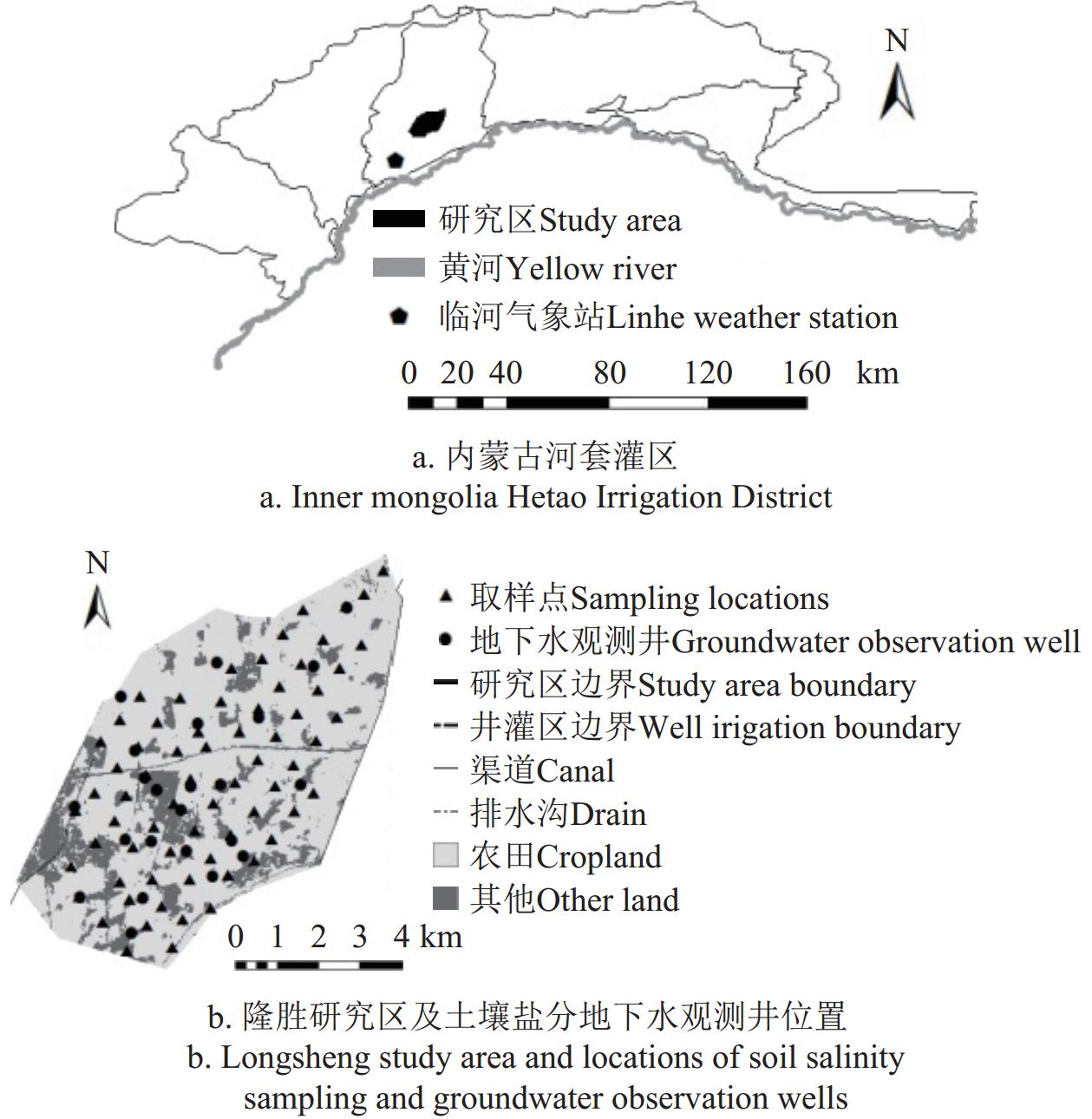
 下载:
下载:
